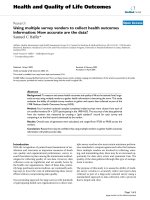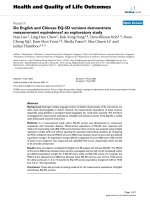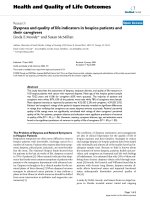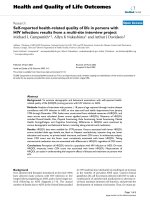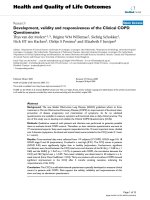Health and Quality of Life Outcomes BioMed Central Research Open Access A new instrument to pot
Bạn đang xem bản rút gọn của tài liệu. Xem và tải ngay bản đầy đủ của tài liệu tại đây (223.63 KB, 8 trang )
BioMed Central
Page 1 of 8
(page number not for citation purposes)
Health and Quality of Life Outcomes
Open Access
Research
A new instrument to describe indicators of well-being in old-old
patients with severe dementia – The Vienna List
Franz Porzsolt*
1
, Marina Kojer
2
, Martina Schmidl
2
, Elfriede R Greimel
3
,
Jörg Sigle
4
, Joerg Richter
5
and Martin Eisemann
6
Address:
1
Clinical Economics Group, University Hospital Ulm, D-89075, Germany,
2
Department of Palliative Geriatrics, Geriatric Center
Wienerwald, Vienna, Austria,
3
Department of Obstetrics and Gynecology, University of Graz, Austria,
4
Freudenstein, Germany,
5
Clinic of
Psychiatry and Psychotherapy, Rostock University, Germany and
6
Department of Psychology, University of Tromsø, Norway
Email: Franz Porzsolt* - ; Marina Kojer - ;
Martina Schmidl - ; Elfriede R Greimel - ; Jörg Sigle - ;
Joerg Richter - ; Martin Eisemann -
* Corresponding author
well-beingquality of lifeold-oldsevere dementia
Abstract
Background: In patients with very severe dementia self-rating of quality of life usually is not
possible and appropriate instruments for proxy-ratings are not available. The aim of this project is
to develop an instrument of clinical proxy-ratings for this population.
Methods: Using electronic instruments, physicians and nurses recorded patient behaviour and
changes of behaviour over a period of one year. Based on these data a list of 65 items was generated
and subsequently allocated to 14 categories. This list was tested in 217 patients (61–105 yrs) with
dementia diagnosed according to ICD-10 by both physicians and nurses. The severity of dementia
was assessed by means of the Global Deterioration Scale (GDS) and the Brief Cognitive Rating
Scale (BCRS). The Spitzer-Index (proxy-rating) was used as a global quality of life measure. Activity
of daily living was rated using the Barthel Index.
Results: A factor analysis of the original 65 items revealed 5 factors (communication, negative
affect, bodily contact, aggression, and mobility). By stepwise removing items we obtained
satisfactory internal consistencies of the factors both for nurses' and physicians' ratings. The factors
were generally unrelated. The validity of the instrument was proven by correlations of the factors
communication and mobility with the Brief Cognitive Rating Scale (BCRS) and the Barthel-Index.
Conclusion: The results demonstrate the reliability and validity of the Vienna List as a proxy rating
measurement of quality of life in patients with severe dementia. The psychometric properties of
the scale have to be proved in further studies.
Background
In industrial societies the proportions of old people and
of people suffering from dementia are steadily increasing.
Consequently, the number of people depending on differ-
ent types of institutional care is growing. The care is pro-
vided in general hospitals, geriatric hospitals, nursing
Published: 19 February 2004
Health and Quality of Life Outcomes 2004, 2:10
Received: 09 December 2003
Accepted: 19 February 2004
This article is available from: />© 2004 Porzsolt et al; licensee BioMed Central Ltd. This is an Open Access article: verbatim copying and redistribution of this article are permitted in all
media for any purpose, provided this notice is preserved along with the article's original URL.
Health and Quality of Life Outcomes 2004, 2 />Page 2 of 8
(page number not for citation purposes)
homes, private homes, and senior residences and within
the families. Obviously, there are large differences in costs
and efficacy of these different types of care. In general,
quality of life data have been increasingly appreciated as
the key outcome measure for the assessment of therapeu-
tic interventions and for the usefulness of various treat-
ment facilities. Quality of life is defined by WHO as "an
individual's perception of their position in life, in the con-
text of the culture and value systems in which they live,
and in relation to their goals, expectations, standards, and
concerns. It is a broad ranging concept, effected in a com-
plex way by the person's physical health, psychological
state, level of independence, social relationships and their
relationships to salient features of their environment" [1].
As concerns people with dementia, many of the instru-
ments in use represent brief global measures, which can-
not be applied to patients with severe dementia.
The most important reason for this slow growth of empir-
ical data in this area probably relates to the obvious meth-
odological problems of obtaining reliable subjective
accounts of individuals with severe dementia who have
compromised cognitive abilities, frequently with concur-
rent impaired communicative skills.
Due to these impairments in this group of patients most
of the available instruments are not applicable for assess-
ing quality of life related issues by means of traditional
measures such as questionnaires or interviews which
require a highly complex procedure of introspection and
evaluation, involving several components of cognition
including implicit and explicit memory [2].
Facing these problems, attempts have been made to
develop direct observational methods [3] measuring pos-
itive affects such as pleasure, interest, and contentment as
well as negative affects such as sadness, anxiety/fear, and
anger according to operationalized criteria during a series
of 10-minutes direct observation. An alternative approach
was chosen by the Bradford Research Group in the UK [4]
with the Dementia Care Mapping (DCM) based on the
psychosocial model of "person-centred care" which pro-
vides detailed observational ratings covering aspects of
articulation, feeding, social withdrawal, passive engage-
ment, walking and a number of indicators of well-being.
Literature searches (-2003) of Medline, Embase, Psyclit,
Cinahl using the keywords dementia and well-being and
quality of life were conducted. Lawton et al. [5] developed
the Minimum Data Set (MDS) comprising cognition,
activities of daily living, time use, depression, and prob-
lem behaviours. He proposed to include observations of
demented patients' emotional behaviours [6]. Most of the
measurements are derived from existing instruments and
are confined to few of the following dimensions: affect,
activity, enjoyment, self-esteem, and social interactions
[7]. Ready and Ott concluded from their review [7] that
the psychometric properties of most of the available
instruments have to be regarded as preliminary.
As mentioned above, there were no quality of life assess-
ment tools for patients with very severe dementia as rep-
resentative of our population. Unfortunately, the
instruments developed for demented patients were not
found applicable to our patients who were in much more
advanced stages of dementia (e.g. the Mini Mental State
Examination could not be completed by any of our
patients). For this reason a project was launched in 1998
by the department of Palliative Geriatrics (Geriatriezen-
trum am Wienerwald), to develop a new instrument
based on observations made by the staff (physicians,
nurses and physiotherapists) completely independent on
the patients' cooperation.
Methods
Patients
In the present study 217 consecutive patients (44 males,
173 females) were included. The average age was 84 years
(range 61–105 years). The majority of patients suffered
from severe dementia according to ICD-10 (34,5 % F00 –
Dementia in Alzheimer's Disease; 61,5 % F01 – Vascular
Dementia; 4,0 & F02 – other). It appeared that more
women (38 %) had been diagnosed as suffering from
Alzheimer's disease compared with men (23 % – χ
2
(df =
2) = 6,05; p = 0,049). As concerns age, the patients with
Alzheimer's disease (87,3 ± 5,7 years) and vascular
dementia (86,3 ± 7,0 years) were significantly older than
those with other diagnoses (78,5 ± 15,6 years – t = 3,27; p
= 0,002 and t = 2,74; p = 0,007 respectively).
Development of the item-pool
Thirteen staff members comprising doctor, nurses, and
therapists from the department of Palliative Geriatrics at
the Geriatriezentrum am Wienerwald in Vienna had
observed severely demented patients during a one year
period (May 1998 to April 1999). The patient's behaviour
was documented at one of the wards (32 beds). Based on
this documentation, 65 items for the description of
behaviour in demented inpatients were derived and allo-
cated to categories, supposedly reflecting relevant aspects
of their well-being such as voice, language, mood, eye
contact, acceptance of body contact, gait, muscular ten-
sion, hand movement, sleep, activities, communication,
independence concerning food intake. This approach is
different from prevailing approaches, which mainly are
based on the use of items from existing instruments meas-
uring specific aspects.
Subsequently, by means of this item-list, 771 assessments
of 217 in-patients in various situations such as eating,
Health and Quality of Life Outcomes 2004, 2 />Page 3 of 8
(page number not for citation purposes)
dressing, grooming had been obtained between June
1999 and September 2000 by physicians and nurses. Each
of the original 65 items was scored on a 5-point Likert
scale from 0 = never to 4 = always.
Further assessments
Patients were diagnosed according to ICD-10. They were
rated by means of the Brief Cognitive Rating Scale (BCRS)
[8], the Global Deterioration Scale (GDS) [9], the Barthel-
Index [10], and the Spitzer Index [11].
The BCRS describes the severity of cognitive impairment
providing five main axes (concentration, short term mem-
ory, long term memory, orientation, and self-care ability)
and five co-axes (language, psychomotoric, mood and
behaviour, drawing skills, calculating skills) each rated on
a 7-step scale. The GDS is a proxy rating scale to assess the
severity of dementia in elderly people on a seven point
Likert-type scale (1 = no impairment; 7 = most severe
impairment).
The Barthel-Index was used to assess the activity of daily
living in 10 areas (feeding, transfers bed to chair and back,
grooming, toilet use, bathing, mobility, climbing stairs,
dressing, stool control, bladder control).
The Spitzer Index is a global quality of life measure cover-
ing five areas (activity, daily life, health, social relations,
future) with a maximum score of 10 points.
The BCRS, GDS, and Spitzer Index had been rated by phy-
sicians and the Barthel index by nurses. All ratings includ-
ing the 65 items list were made on the same occasion.
Data collection was carried out using electronic question-
naires implemented through the Quality-of-Life-Recorder
technology [12].
Statistical analysis
Descriptive statistics were generated for demographic data
and diagnostic categories and for the BCRS and GDS
scales, for the Barthel and Spitzer Indices, as well as for the
newly developed instrument.
A factor analysis (principle component analysis, oblimin
with Kaiser normalisation as rotation method), based on
these 771 assessments was performed. The number of
interpretable factors was determined by interpretation of
a Scree plot. The consistency of the factors was tested by
Cronbach's alpha coefficients. To improve the consistency
of the scales, items have been deleted based on the criteria
of changes in magnitude of the Cronbach's alpha coeffi-
cients and on the fit of the item with the content of the
core items of the factors. To test the stability of the factor
structure, we conducted separate analyses for doctors and
nurses. For testing construct validity, we used the two
external criteria, Brief Cognitive Rating Scale and the
Barthel-Index.
To test for inter-rater reliability Spearman rank correlation
coefficients were calculated. We included only data in
which the electronic recording confirmed that it was
obtained at exactly the same time.
Results
Most patients suffered from severe dementia as indicated
by the results of the BCRS (mean ± SD: 57 ± 8.8) and GDS
(mean ± SD: 5.7 ± 1.1) and the low level of activity of
daily living (mean ± SD of Barthel Index: 26.8 ± 29.7) in
the present sample also reflected by the distribution of
diagnoses according to ICD-10.
Of the 771 assessments 386 had been performed by
nurses and 385 assessments by physicians. By means of
the electronic recordings we identified 22 pairs of assess-
ments made at the same time by a nurse and a physician.
A planned feasibility analysis after 120 assessments
resulted in the exclusion of the Spitzer Index because of a
general floor effect (mean score <3).
The factor analysis suggested five factors based on the
interpretation of the Scree plot. The results of the five-fac-
tor solution are given in Table 1 with high Eigenvalues
and an explained variance of more than 60 per cent.
Table 1: Eigenvalues and explained amounts of variance for the 5-factor solution
Eigenvalues % of Variance Cumulative %
Factor nurse physician nurse physician nurse physician
1 10.0 10.7 24.4 26.0 24.4 26.0
2 5.7 6.1 13.8 15.0 38.2 41.0
3 4.9 4.8 11.9 11.8 50.0 52.1
4 2.5 2.1 6.1 5.0 56.1 58.0
5 2.0 2.5 4.9 6.1 61.0 63.9
Extraction Method: Principal Component Analysis.
Health and Quality of Life Outcomes 2004, 2 />Page 4 of 8
(page number not for citation purposes)
Table 2: Structure Matrix
Factor12345
Nurse Physician Nurse Physician Nurse Physician Nurse Physician Nurse Physician
Communication
ITEM 59 0.82 0.83 -0.19 -0.14 0.04 -0.32 0.29 0.05 0.06 0.25
ITEM 62 0.81 0.64 0.02 0.16 0.08 -0.39 0.28 0.22 -0.09 0.34
ITEM 6 0.79 0.78 -0.26 0.13 -0.07 -0.29 0.18 0.08 0.10 0.17
ITEM 61 0.79 0.67 -0.23 -0.13 0.10 -0.56 0.22 0.09 0.08 0.25
ITEM 8 0.78 0.81 -0.20 0.08 -0.16 -0.25 0.14 0.12 0.12 0.18
ITEM 65 0.73 0.77 -0.27 -0.13 -0.05 -0.05 0.52 0.10 0.01 0.48
ITEM 56 0.70 0.69 -0.08 0.08 -0.15 0.07 0.07 -0.06 0.05 0.10
ITEM 14 0.70 0.85 -0.11 -0.11 0.02 -0.10 0.44 -0.06 0.15 0.26
ITEM 32 0.66 0.64 -0.14 -0.06 0.35 -0.48 0.03 -0.11 0.15 0.22
ITEM 31 0.65 0.65 -0.12 0.01 0.32 -0.54 0.08 0.00 0.15 0.19
ITEM 13 0.64 0.76 -0.24 -0.04 0.06 -0.42 0.11 0.13 0.12 0.20
ITEM 50 0.64 0.77 -0.40 -0.19 -0.04 -0.17 0.46 -0.03 0.19 0.35
ITEM 64 0.62 0.61 0.05 0.13 0.06 -0.17 0.49 -0.21 0.03 0.40
ITEM 60 0.59 0.69 0.12 0.17 -0.27 0.03 0.01 0.28 -0.11 0.07
ITEM 15 0.45 0.73 0.03 -0.13 -0.08 0.19 0.34 -0.19 0.12 0.06
Negative Affect
ITEM 18 -0.08 0.04 0.83 0.87 -0.03 -0.14 -0.08 0.11 -0.28 -0.02
ITEM 22 -0.04 0.09 0.80 0.74 0.11 -0.34 -0.10 0.08 -0.20 0.00
ITEM 3 -0.07 0.02 0.75 0.82 0.16 -0.18 -0.13 0.17 -0.11 -0.06
ITEM 24 -0.09 -0.01 0.74 0.76 -0.05 -0.18 -0.05 0.12 -0.37 0.08
ITEM 27 0.04 0.02 0.66 0.77 -0.13 -0.10 -0.17 0.45 -0.45 -0.05
ITEM 17 -0.28 -0.17 0.66 0.71 -0.08 0.14 -0.16 0.38 -0.58 -0.12
ITEM 25 -0.30 0.17 0.65 0.63 0.03 -0.02 -0.29 -0.02 -0.08 -0.07
ITEM 54 -0.20 -0.20 0.62 0.58 -0.09 0.10 0.19 0.28 -0.34 0.05
ITEM 53 -0.10 -0.01 0.60 0.50 -0.07 0.23 0.14 0.17 -0.28 0.01
ITEM 47 -0.28 -0.26 0.53 0.61 0.00 0.11 -0.26 0.37 -0.45 -0.11
Bodily contact
ITEM 35 0.00 0.17 0.02 -0.03 0.93 -0.76 -0.08 -0.13 0.11 -0.11
ITEM 34 0.01 0.27 0.00 0.07 0.93 -0.81 -0.09 -0.12 0.12 -0.09
ITEM 33 0.03 0.37 0.00 0.14 0.90 -0.77 -0.09 -0.06 0.12 0.00
ITEM 36 -0.06 -0.21 0.01 0.10 0.89 -0.81 -0.13 -0.15 0.16 -0.08
ITEM 37 -0.06 -0.27 0.01 0.15 0.86 -0.76 -0.12 -0.16 0.17 -0.06
Aggression
ITEM 4 -0.14 0.01 0.25 0.27 -0.19 0.08 0.13 0.91 -0.88 0.08
ITEM 19 -0.24 -0.05 0.31 0.18 -0.22 0.16 0.13 0.84 -0.83 0.09
ITEM 1 0.05 0.20 0.28 0.20 -0.07 0.12 0.01 0.71 -0.78 0.08
ITEM 29 0.22 0.11 0.20 0.21 -0.10 0.05 0.03 0.84 -0.77 0.15
Mobility
ITEM 40 0.42 0.56 -0.31 -0.23 -0.20 0.08 0.79 -0.14 0.22 0.80
ITEM 41 0.49 0.64 -0.28 -0.27 -0.23 0.07 0.71 -0.19 0.23 0.63
ITEM 57 0.01 0.01 0.01 0.08 -0.05 0.00 0.68 0.14 -0.18 0.70
ITEM 42 0.04 0.07 0.07 0.06 -0.02 0.05 0.68 0.20 -0.18 0.80
ITEM 43 0.43 0.63 -0.43 -0.15 -0.08 -0.09 0.66 0.00 0.22 0.64
ITEM 55 0.41 0.46 -0.14 -0.07 -0.10 0.04 0.42 -0.23 0.03 0.34
Extraction Method: Principal Component Analysis. Rotation Method: Oblimin with Kaiser Normalization.
Health and Quality of Life Outcomes 2004, 2 />Page 5 of 8
(page number not for citation purposes)
To improve the consistency of the five factors, 18 of the
original 65 items were deleted based on the criteria of
changes in magnitude of the Cronbach alpha coefficients
and on the fit of the item with the content of the core
items of the factors. As a next step, eight further items were
excluded due to different factor-loadings between raters
and of content considerations resulting in the following
five factors: communication (15 items), negative affect
(10 items), bodily contact (5 items), aggression (4 items)
and mobility (6 items). The factor structure matrix includ-
ing the single items for physicians and nurses is shown in
table 2 and demonstrates a high congruency of the factor
structure between both groups of raters on the item level.
In addition, it appeared that the factors were generally
unrelated to each other except for significant correlations
between the factors 'communication' and 'bodily contact'
(r = 0.25; p < 0.001 each) and of 'mobility' with 'negative
affect' (physicians: r = 0.22; p = 0.001; nurses: r = -0.33; p
< 0.01). The Cronbach alpha coefficients as a measure of
internal consistency were high for both nurses and physi-
cians (table 3). The congruence of nurses' and physician's
ratings is further demonstrated by similar item severity
(relative ratings) and selectivity of the single factors (table
4).
Table 3: Cronbach alpha coefficients
Factor Number of Items Nurse Physician
1 – Communication 15 0.93 0.94
2 – Negative Affect 10 0.88 0.89
3 – Bodily Contact 5 0.90 0.90
4 – Aggression 4 0.86 0.87
5 – Mobility 6 0.81 0.82
Table 4: Item severity and Item selectivity
Item severity Item selectivity
Communication Nurse Physician Nurse Physician
59 Responding to distant
calls
0.57 0.63 0.82 0.85
62 Looking for contact 0.53 0.56 0.81 0.71
06 Speaks comprehensibly 0.64 0.69 0.79 0.81
61 Contact possible 0.83 0.90 0.79 0.74
08 Speaks meaningful
groups of words
0.59 0.68 0.77 0.82
65 Eats and drinks by him-/
herself
0.66 0.68 0.79 0.78
56 Reads newspaper 0.24 0.19 0.69 0.64
14 Carries out simple
orders
0.39 0.64 0.73 0.84
32 Maintains visual contact 0.72 0.74 0.65 0.71
31 Visual contact possible 0.80 0.85 0.63 0.72
13 Comprehends single
words
0.89 0.88 0.63 0.81
50 Uses both hands
intentionally
0.62 0.67 0.70 0.79
64 Worries about others 0.25 0.23 0.65 0.63
60 Rings the bell 0.29 0.31 0.58 0.67
15 Carries out complicated
orders
0.08 0.24 0.47 0.64
Negative Affect
18 Full of despair 0.40 0.43 0.82 0.86
22 Sad/crying 0.32 0.36 0.77 0.75
03 Whining voice 0.33 0.32 0.72 0.83
Health and Quality of Life Outcomes 2004, 2 />Page 6 of 8
(page number not for citation purposes)
For testing construct validity, we used two external crite-
ria, the Brief Cognitive Rating Scale (BCRS) used by phy-
sicians and the Barthel-Index used by nurses (table 5). The
correlation coefficients between the various areas of the
BCRS and the two relevant scales of the new instrument
(communication and mobility) point to a satisfactory
validity. Concerning the second criteria, the Barthel-Index
(a measure of activities of daily living), it was significantly
correlated with the scales "communication" and "mobil-
ity" of our instrument. Furthermore, the latter was
correlated with the scale "negative affect" and "acceptance
of body contact" in the expected direction.
When testing for gender differences concerning the fac-
tors, we found significant differences for all but one factor
(table 6).
The interrater-reliability between sub-samples of physi-
cians and nurses proved to be satisfactory (table 7).
Discussion
The special problem in the assessment of well-being in
patients with severe dementia is their lack of competence
which is compromising the reliability of their reports.
Consequently, observer ratings are the only alternative for
such self-ratings. However, observer ratings inherit the
potential risk of overrating the well-being of patients if the
provider and rater of health care services are identical. We
have controlled for this risk by semi-quantitatively
describing the frequency of distinct behaviour patterns in
demented patients.
The results of this study demonstrate that the behaviour of
old-old patients with severe dementia can be described by
five factors of the Vienna List. By explaining more than
24 Nervous/anxious 0.37 0.40 0.76 0.75
27 Wailing 0.30 0.31 0.69 0.80
17 Tensed 0.36 0.43 0.73 0.72
25 Resignated 0.27 0.38 0.65 0.63
54 Restless/confused 0.25 0.31 0.62 0.59
53 Problems to fall asleep 0.25 0.36 0.59 0.49
47 Muscular tension 0.37 0.43 0.60 0.62
Bodily Contact
35 Bodily contact possible
at shoulders
0.77 0.87 0.92 0.78
34 Bodily contact possible
at arms
0.81 0.91 0.90 0.80
33 Bodily contact possible
at hands
0.82 0.94 0.88 0.73
36 Bodily contact possible
at the head
0.63 0.63 0.91 0.88
37 Bodily contact possible
in the face
0.56 0.55 0.88 0.84
Aggression
04 Aggressive voice 0.27 0.27 0.89 0.90
19 Aggressive acts 0.21 0.19 0.85 0.84
01 Loud voice 0.32 0.33 0.80 0.80
29 Insulting others 0.23 0.22 0.81 0.88
Mobility
40 Walking upright 0.37 0.40 0.92 0.95
41 Walking straightup to 0.33 0.36 0.87 0.87
57 Departs from ward 0.07 0.05 0.53 0.46
42 Wanders around 0.16 0.17 0.53 0.62
43 Sitting upright 0.57 0.57 0.80 0.81
55 Ready to help on ward 0.13 0.09 0.55 0.54
Table 4: Item severity and Item selectivity (Continued)
Health and Quality of Life Outcomes 2004, 2 />Page 7 of 8
(page number not for citation purposes)
60% of the total variance these five factors obviously cover
a considerable part of the possible spectrum of behaviour
in these patients.
Since nurses and physicians have different intensity of
contact and corresponding different perspectives, it was
surprising that their assessments were highly correlated in
three of the five factors. The two factors, aggression and
mobility, yielded higher scores among the nurses as com-
pared to doctors.
Table 5: Correlations with BCRS scores and Barthel Index
Communication Negative Affect Bodily contact Aggression Mobility
Physicians
BCRS 1 –
concentration
-0.71* 0.05 0.07 -0.02 -0.45*
BCRS 2 – short time
memory
-0.67* 0.02 0.11 -0.01 -0.42*
BCRS 3 – long time
memory
-0.68* 0.14 0.09 0.08 -0.46*
BCRS 4 – orientation -0.65* 0.12 0.12 0.11 -0.40*
BCRS 5 – everyday life
competency
-0.47* -0.04 -0.04 -0.10 -0.44*
BCRS 6 – language -0.71* -0.02 0.02 -0.09 -0.37*
BCRS 7 –
psychomotorics
-0.41* -0.01 0.06 -0.10 -0.59*
BCRS 8 – mood and
behaviour
-0.60* 0.10 -0.02 0.03 -0.34*
BCRS 9 – constructive
skills
-0.55* 0.03 0.02 -0.06 -0.34*
BCRS 10 – calculation
skills
-0.59* 0.17* 0.09 0.09 -0.35*
Main axis -0.73* 0.07 0.09 0.02 -0.49*
Co-axis -0.71* 0.07 0.04 -0.03 -0.49*
BCRS total score -0.74* 0.07 0.06 -0.01 -0.50*
Nurses
Barthel Item 1 –
feeding
0.70* -0.21* -0.10 0.02 0.63*
Barthel Item 2 –
transfer
0.46* -0.27* -0.17* -0.08 0.83*
Barthel Item 3 –
personal care
0.41* -0.17* -0.02 -0.12 0.36*
Barthel Item 4 – toilet
use
0.47* -0.25* -0.20* -0.12 0.67*
Barthel Item 5 –
bathing
0.08 -0.07 0.04 -0.06 0.09
Barthel Item 6 –
moving
0.43* -0.28* -0.18* -0.09 0.83*
Barthel Item 7 – stairs 0.32* -0.23* -0.14 -0.03 0.72*
Barthel Item 8 –
dressing
0.51* -0.23* -0.22* -0.09 0.67*
Barthel Item 9 –
bowel
0.48* -0.20* -0.16* -0.15* 0.57*
Barthel Item 10 –
bladder control
0.44* -0.20* -0.22* 0.14 0.56*
Barthel Index 0.56* -0.28* -0.20* -0.10 0.83*
* p < 0.001
Health and Quality of Life Outcomes 2004, 2 />Page 8 of 8
(page number not for citation purposes)
As concerns aggression, there are mainly two explanations
for this difference. Firstly, nurses spend more time and
have closer contact with the patients and consequently
have a higher risk to induce aggressive behaviour in the
patients. In addition, the extended period of contact
increases the chance to experience an episode of aggres-
sive behaviour. Secondly, patients normally behave differ-
ently towards nurses and doctors due to differences in role
expectation and familiarity related to the frequency of
contact. However, we consider this later explanation as
unlikely in these patients due to their cognitive
impairment.
Regarding mobility it is plausible that the doctors report
lower scores for mobility of the patients as the doctor
mainly sees the patient under certain circumstances, i.e.
during the rounds where the ward routines limit the
mobility of the patient.
Since these five factors encompass most of the behav-
ioural repertoire of demented old-old patients we assume
that these factors can be regarded as a useful approach to
describe the well-being in these patients.
Acknowledgements
Supported by the Guest Professorship Program University of Ulm and a Sci-
entific Medical Grant from the Mayor of the City of Vienna.
References
1. The WHOQOL group: The World Health Organization Qual-
ity of Life assessment (The WHOQOL): position paper from
the World Health Organization. Soc Sci Med 1995,
41:1403-1409.
2. Barofsky I: Cognitive aspects of quality of life assessment. in:
Quality of life and pharmacoeconomics in clinical trials Edited by: Spilker
B. Philadelphia, New York, Lippincott-Raven Publishers; 1996.
3. Lawton MP, Van Haitsma K, Klapper J: Observed affect in nursing
home residents with Alzheimer's disease. J Gerontol B Psychol Sci
Soc Sci 1996, 51:3-14.
4. Kitwood T, Bredin K: Evaluating dementia care: the DCM method 7th
edition. Bradford, England: Bradford Dementia Research Group, Bradford
University; 1997.
5. Lawton MP, Carsten R, Parmelee PA, van Haitsma K, Corn J, Kleban
MH: Psychometric characteristics of the minimum data set
II: validity. J Am Geriat Soc 1998, 46:736-744.
6. Lawton MP: Quality of life in Alzheimer disease. Alzheimer Dis
Assoc Disord 1994, 8(suppl 3):138-150.
7. Ready RE, Ott BR: Quality of life measures for dementia. Health
Qual Life Outcomes 2003, 1:1-9.
8. Reisberg B, Schneck MK, Ferris SH, Schwartz GE, de Leon MJ: The
Brief Cognitive Rating Scale(BCRS): Findings in primary
degenerative dementia (PDD). Psychopharmacol Bull 1983,
19:47-50.
9. Reisberg B, Ferris SH, de Leon MJ, Crook T: The Global Deterio-
ration Scale (GDS). Psychopharmacol Bull 1982, 24:629-636.
10. Mahoney F, Barthel DW: Functional evaluation: the Barthel
Index. Maryland State Med J 1965, 14:61-65.
11. Spitzer WO, Dobson AJ, Hall J: Measuring the quality of life of
cancer patients. J Chronic Dis 1981, 34:585-597.
12. Sigle J, Porzsolt F: Practical aspects of quality of life measure-
ment: Design and feasibility study of the Quality-of-Life-
Recorder and the standardized measurement of quality of
life in an outpatient clinic. Cancer Treat Rev 1996, 22:75-90.
Table 6: Factor Scores of Observations by Gender of the Patients
Factor Observations of Males (x ±
SD) N = 123
Observations of Females (x
± SD) N = 648
t-score p value
1 – Communication 34.8 ± 13.2 33.8 ± 11.8 0.82 0.415
2 – Negative Affect 9.5 ± 6.7 14.8 ± 6.7 -8.37 <0.001
3 – Bodily Contact 14.9 ± 4.3 16.7 ± 4.9 -4.18 <0.001
4 – Aggression 3.1 ± 3.0 4.3 ± 3.5 -3.21 0.001
5 – Mobility 8.1 ± 5.5 6.3 ± 5.5 3.38 0.001
Table 7: Paired sample test and Spearman Rank correlation coefficients between nurses and physicians related to the same patient at
the same day (22 pairs)
Factor Nurse (x ± SD) Physician (x ± SD) t-score/p R/p
1 – Communication 25.8 ± 10.5 26.4 ± 8.9 -0.35/0.727 0.71/<0.001
2 – Negative Affect 11.9 ± 7.6 8.6 ± 5.0 2.46/0.023 0.57/0.006
3 – Bodily contact 15.9 ± 5.7 18.4 ± 2.9 -2.22/0.038 0.53/0.011
4 – Aggression 4.3 ± 3.0 2.2 ± 2.1 3.69/0.001 0.35/0.112
5 – Mobility 6.5 ± 5.7 5.1 ± 5.8 2.03/0.056 0.81/<0.001


